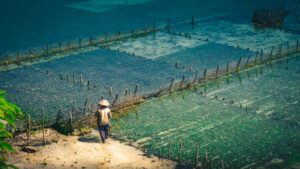by Ingrid Gercama, Nathalie Bertrams, Tristen Taylor
 Claire O’Sullivan runs her small family firm, Wild Atlantic Seaweed Ireland, out of her house a short walk from Bantry Bay on the country’s southwestern coast. Her wild kelp is hand-harvested, a sustainable and traditional method of collecting seaweed. The company focuses on niche high-end products: Seaweed Infused Beard Oil, €15.00 for 50 milliliters ($14.66 for 1.7 fluid ounces), and Chilli and Lemongrass Seaweed Pesto, €5.60 for 100 grams ($5.43 for 3.5 ounces).
Claire O’Sullivan runs her small family firm, Wild Atlantic Seaweed Ireland, out of her house a short walk from Bantry Bay on the country’s southwestern coast. Her wild kelp is hand-harvested, a sustainable and traditional method of collecting seaweed. The company focuses on niche high-end products: Seaweed Infused Beard Oil, €15.00 for 50 milliliters ($14.66 for 1.7 fluid ounces), and Chilli and Lemongrass Seaweed Pesto, €5.60 for 100 grams ($5.43 for 3.5 ounces).
Since seaweed is packed with vitamins, fiber, protein and antioxidants, it has joined kale and quinoa to become a superfood. “My grandmother swore by carrageen moss,” O’Sullivan says. “She had everyone eating seaweed and she lived to be 103 years old. And my nanny was the same and she reached 100.”
But O’Sullivan’s company is only a tiny part of the massive global seaweed industry, currently worth an estimated €40 billion ($39.2 billion). According to the U.N.’s Food and Agriculture Organization (FAO), the world harvested 35.8 million metric tons in 2019. Asia accounted for 97% of total production, of which China produced 57%.
Now Europe wants in. Along with Ireland and other member states, the European Commission is planning large-scale industrial farming of seaweed across the continent’s shores. The goal is to farm 8 million metric tons of seaweed annually by 2030, according to a statement the commission provided to Mongabay, up from Europe’s current annual production of farmed seaweed of about 3,000 metric tons.
Seaweed for Europe, an industry lobby group based in Brussels, worked with the European Commission to develop this goal. Kelp cultivation “provides essential food and habitat to the ocean ecosystem, and it’s a form of farming that needs no fresh water, fertiliser or cleared land,” Adrien Vincent, an associate at the lobby group, wrote in an email. “It can be a really important part of a sustainable and healthy ocean economy.”
If the goal of 8 million metric tons per annum is achieved, Vincent estimates that the European seaweed industry’s market value in 2030 would be €9.3 billion ($9.1 billion).
The commission and the European Investment Fund are providing €1.5 billion ($1.47 billion) of financing for the blue economy, and the industry is moving ahead. However, the science hasn’t caught up. The potential ecological impacts of nutrient depletion, genetic pollution and disease have all yet to be assessed completely.
“As the global seaweed aquaculture industry grows and diversifies, the risk of introducing known and emerging pests and diseases to the new regions will escalate,” Elizabeth Cottier-Cook, a marine biologist with the Scottish Association for Marine Science, points out in a 2021 policy paper. “However, there is no co-ordinated global effort to support seaweed research, to build and to transfer technical capacities and to protect wild seaweed populations.”
Seas At Risk is a coalition of 30 organizations working to protect Europe’s marine environment headquartered in Brussels. The organization’s marine policy officer, Marc-Philip Buckhout, has a more cautious view of large-scale seaweed production than lobby groups like Seaweed for Europe. “I have a worry that it is the next green thing,” he says. “And that in a few years from now, when we are more aware of the negative implications, the hype is going to be met with a bit of a reality check.”
Growing between wind farms
One of the critical requirements for the kelp industry’s growth is “automation/industrialisation to allow for scaled production,” Lisa Evers, a press officer with Ireland’s Department of Agriculture, Food and the Marine wrote in a statement. That is precisely what is being developed in the Netherlands.
The Netherlands initially considered allocating 14,000 square kilometers (5,405 square miles) out of its 57,000-km² (22,000-mi2) North Sea exclusive economic zone for seaweed cultivation, but is now planning for a total of 400 km² (154 mi2).
Seaweed would first be cultivated in nearshore hatcheries until the plants are robust enough to be hung out in the farms. These would be in existing and planned offshore wind parks. The seaweed would then grow in the open ocean on nets, which would be attached to long floating tubes that in turn would be anchored with concrete blocks on the seafloor.
Since the waters between the wind turbines are restricted, seaweed farming is one of the few activities that could make use of the space.
The basic concept is to develop “a sustainable resource for the European markets. So that we may have a more circular way of living in the future,” Eef Brouwers, the manager for farming and technology at the Hague-based lobby group North Sea Farmers, says. “That’s a great dream. But then you have to try to realize it in practice.”
Leave a Reply